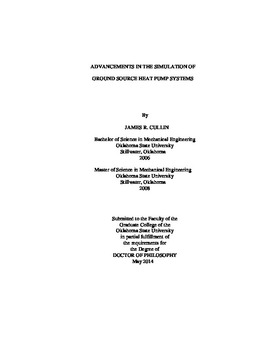| dc.contributor.advisor | Spitler, Jeffrey D. | |
| dc.contributor.author | Cullin, James R. | |
| dc.date.accessioned | 2015-06-17T20:05:25Z | |
| dc.date.available | 2015-06-17T20:05:25Z | |
| dc.date.issued | 2014-05 | |
| dc.identifier.uri | https://hdl.handle.net/11244/14786 | |
| dc.description.abstract | With ground source heat pump systems becoming an increasing focus in the building energy efficiency sector, fully understanding their behavior is key. For systems such as these, computer simulation is typically performed to design them, or to examine their potential energy performance. Therefore, having detailed simulations that take into account all relevant behaviors of these systems is of the utmost importance. | |
| dc.description.abstract | After discussing the current state of ground source heat pump system simulation, a first-order analysis shows that the horizontal piping in a vertical borehole system can play a very significant effect on the overall performance, and that the selection of the design temperatures can influence the long-term behavior of the system. To further delve into particular aspects of ground source heat pump behavior, a new, detailed model is developed that focuses much computational effort on the area surrounding the borehole, which possesses the highest temperature gradient and therefore the highest heat transfer rate. | |
| dc.description.abstract | The new model, as well as a widely-used existing model, are then validated against multiple experimental data sets. This validation shows that the new model performs well for smaller systems, but struggles when the number of boreholes increases due to computation time. Meanwhile, the existing model performs well for typical systems of all sizes; where it fails, though, is in failing to account for thermal short-circuiting inside the borehole, which becomes significant as the fluid residence time grows. | |
| dc.description.abstract | Finally, two notable design methodologies are also validated. One, a simulation-based standalone design tool, sizes systems very accurately, and the error falls within the range attributable to not using a more detailed hourly simulation. On the other hand, the current ASHRAE Handbook design equation fails to predict the lengths with any accuracy; this is predominantly due to the simplistic nature in which it represents the building loads. | |
| dc.format | application/pdf | |
| dc.language | en_US | |
| dc.rights | Copyright is held by the author who has granted the Oklahoma State University Library the non-exclusive right to share this material in its institutional repository. Contact Digital Library Services at lib-dls@okstate.edu or 405-744-9161 for the permission policy on the use, reproduction or distribution of this material. | |
| dc.title | Advancements in the simulation of ground source heat pump systems | |
| dc.contributor.committeeMember | Fisher, Daniel E. | |
| dc.contributor.committeeMember | Ghajar, Afshin J. | |
| dc.contributor.committeeMember | Beier, Richard A. | |
| osu.filename | Cullin_okstate_0664D_13315.pdf | |
| osu.accesstype | Open Access | |
| dc.type.genre | Dissertation | |
| dc.type.material | Text | |
| dc.subject.keywords | geothermal | |
| dc.subject.keywords | ground source heat pump | |
| dc.subject.keywords | heat exchanger | |
| dc.subject.keywords | heat transfer | |
| dc.subject.keywords | numerical modeling | |
| thesis.degree.discipline | Mechanical Engineering | |
| thesis.degree.grantor | Oklahoma State University | |
